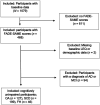Environmental enrichment is associated with favorable memory-related functional brain activity patterns in older adults
- PMID: 39777046
- PMCID: PMC11704887
- DOI: 10.3389/fnagi.2024.1451850
Environmental enrichment is associated with favorable memory-related functional brain activity patterns in older adults
Abstract
Background: In humans, environmental enrichment (EE), as measured by the engagement in a variety of leisure activities, has been associated with larger hippocampal structure and better memory function. The present cross-sectional study assessed whether EE during early life (13-30 years) and midlife (30-65 years) is associated with better preserved memory-related brain activity patterns in older age.
Methods: In total, 372 cognitively unimpaired older adults (aged ≥60 years old) of the DZNE-Longitudinal Study on Cognitive Impairment and Dementia (DELCODE; DRKS00007966) were investigated. EE was operationalized using items of the Lifetime of Experiences Questionnaire (LEQ), which measures the self-reported participation in a variety of leisure activities in early life and midlife. The preservation of memory-related functional brain activity was assessed using single-value scores, which relate older adults' brain activity patterns in the temporo-parieto-occipital memory network to those of young adults during visual memory encoding (FADE and SAME scores).
Results: EE during early life and midlife was significantly associated with higher SAME scores during novelty processing (n = 372, β = 0.13, p = 0.011). Thus, older participants with higher EE showed greater similarity of functional brain activity patterns during novelty processing with young adults. This positive association was observed most strongly in participants with subjective cognitive decline (SCD, n = 199, β = 0.20, p = 0.006).
Conclusion: More frequent participation in a variety of leisure activities in early life and midlife is associated with more successful aging of functional brain activity patterns in the memory network of older adults, including participants at increased risk for dementia. Longitudinal studies are needed to clarify whether higher EE during life could help preserve memory network function in later life.
Keywords: dementia; memory network; multimodal leisure activities; prevention; subjective cognitive decline.
Copyright © 2024 Hass, Liebscher, Richter, Fliessbach, Laske, Sodenkamp, Peters, Hellmann-Regen, Ersözlü, Priller, Spruth, Altenstein, Röske, Schneider, Schütze, Spottke, Esser, Teipel, Kilimann, Wiltfang, Rostamzadeh, Glanz, Incesoy, Lüsebrink, Dechent, Hetzer, Scheffler, Wagner, Jessen, Düzel, Glöckner, Schott, Wirth and Klimecki.
Conflict of interest statement
The authors declare that the research was conducted in the absence of any commercial or financial relationships that could be construed as a potential conflict of interest. The author(s) declared that they were an editorial board member of Frontiers, at the time of submission. This had no impact on the peer review process and the final decision.
Figures



Similar articles
-
Long-term environmental enrichment is associated with better fornix microstructure in older adults.Front Aging Neurosci. 2023 Aug 28;15:1170879. doi: 10.3389/fnagi.2023.1170879. eCollection 2023. Front Aging Neurosci. 2023. PMID: 37711996 Free PMC article.
-
Short communication: Lifetime musical activity and resting-state functional connectivity in cognitive networks.PLoS One. 2024 May 2;19(5):e0299939. doi: 10.1371/journal.pone.0299939. eCollection 2024. PLoS One. 2024. PMID: 38696395 Free PMC article.
-
Design and first baseline data of the DZNE multicenter observational study on predementia Alzheimer's disease (DELCODE).Alzheimers Res Ther. 2018 Feb 7;10(1):15. doi: 10.1186/s13195-017-0314-2. Alzheimers Res Ther. 2018. PMID: 29415768 Free PMC article.
-
Age differences in the neural correlates of novelty processing: The effects of item-relatedness.Brain Res. 2015 Jul 1;1612:2-15. doi: 10.1016/j.brainres.2014.08.006. Epub 2014 Aug 19. Brain Res. 2015. PMID: 25149192 Review.
-
Computerised cognitive training for 12 or more weeks for maintaining cognitive function in cognitively healthy people in late life.Cochrane Database Syst Rev. 2020 Feb 27;2(2):CD012277. doi: 10.1002/14651858.CD012277.pub3. Cochrane Database Syst Rev. 2020. PMID: 32104914 Free PMC article.
References
-
- Anatürk M., Demnitz N., Ebmeier K. P., Sexton C. E. (2018). A systematic review and meta-analysis of structural magnetic resonance imaging studies investigating cognitive and social activity levels in older adults. Neurosci. Biobehav. Rev. 93, 71–84. doi: 10.1016/j.neubiorev.2018.06.012, PMID: - DOI - PMC - PubMed
-
- Anatürk M., Suri S., Smith S. M., Ebmeier K. P., Sexton C. E. (2021). Leisure activities and their relationship with MRI measures of brain structure, functional connectivity, and cognition in the UK biobank cohort. Front. Aging Neurosci. 13:734866. doi: 10.3389/fnagi.2021.734866, PMID: - DOI - PMC - PubMed
LinkOut - more resources
Full Text Sources

